"That day, to have some fun, Pierre went to the village of Vorontsov to see the great air balloon that Leppich was building to defeat the enemy, and the test balloon that was to be launched the next day. The balloon was not ready yet; it was built, Pierre found out, at the monarch's request, wrote Leo Tolstoy in his epochal work War and Peace. And it was not literary fiction. The Russian secret weapon could indeed make the slaughter at Borodino even bloodier.
It is not known what would have been the course of the Napoleonic wars if their initiator had waged them using the technical innovations of that time - the underwater fleet or the air force.
After all, working until 1804 in France, Robert Fulton proposed to the emperor to use his submarine Nautilus to attack the British Isles. But even though Napoleon had every idea to defeat the hated Albion, he found that "such a method of acting against the enemy is dishonest" . Consequently, Fulton made a private invasion and switched to the British Pot, creating machines to defend the islands against the Corsican devil.
Ballooned
More promising was the case with the flying machines of that time - balloons. The Montgolfier brothers' invention, presented in 1783, quickly found a military application. Beginning with the Battle of Fleurs, victorious for the French in 1794, balloons increasingly appeared over the battlefields, making it easier to observe enemy maneuvers and to transmit reports and messages.
Napoleon also seemed to recognize the extraordinary potential of the new invention. In the invasion of England prepared since 1802, the emperor did not rule out the use of a fleet of balloons to deploy huge masses of troops to the other side of the English Channel.
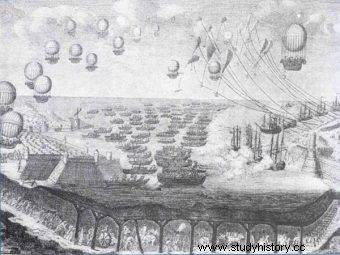
This is what the ... balloon invasion of Great Britain was supposed to look like!
Unfortunately, as historian Kamil Janicki writes:"Sophie Blanchard, responsible for the air invasion project, cooled the ruler's enthusiasm, predicting that the invasion would not be successful due to too strong gusts of wind." In this situation, discouraged, Napoleon abandoned his work on the military use of balloons and focused on much more mundane matters - endless battles with successive coalitions - in which speed of action and assaults mattered.
The topic of balloons, however, did not go far and soon was to be on the mind of the emperor of the French again.
The dice have been rolled
Meanwhile, Tsar Alexander I was irritated by Napoleon's domination of Europe. His state was also bothered by the continental blockade directed against Great Britain. As a result, in December 1810, Russia withdrew from this system and opened its ports to English goods.
What's more, she also established contacts with the anti-French opposition in German states, and in the Russian headquarters started a brainstorming plan for an offensive attack on French Europe. In fact, Napoleon did fear this turn of events for a while.
However, maintaining power required successive victories from him. Without them, it was impossible to consolidate the empire, Napoleonic order and overcome all crises. And the emperor, as a seasoned strategist and a decent politician, knew it very well.
However, unable to defeat Great Britain, which he had always considered - and with good reason - to be the driving force of all the conflicts so far, he decided to defeat ... Russia. He was aware of the tsar's disloyalty and his dealings with London.
Napoleon's Great Army
And although Napoleon must have considered the enormous scale of risk posed by the war with yet a powerful ally, defeating Alexander was to complete the work of creating a pan-European order and peace. "Spain will fall as soon as I annihilate English influence in St. Petersburg" - he was supposed to justify the expedition of 1812, referring to the English participation in the anti-French war on the Iberian Peninsula. After all, one thing was for sure - Europe has become too small for two emperors.
To prove his right to rule over the Old Continent, the emperor of the French gathered powerful forces. Numbering over 600 thousand. people (including approx. 450,000 line soldiers) supported by nearly 1,300 guns The Great Army really deserved such a name . And although it consisted of nearly 20 nations, Napoleon's charisma and military happiness seemed to speak in its favor. Moreover, as historian Piotr Hapanowicz emphasizes:
the Napoleonic army was superior to the opponent not only in number but also in quality. It had a better trained officer corps, more sappers, newer artillery. He himself did not doubt his victory .
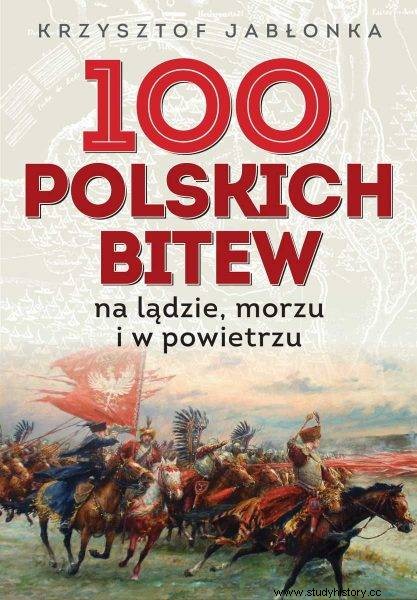
The text was created, among others based on Krzysztof Jabłonka's book “100 Polish Battles. On land, sea and in the air ”, which has just been released by the Zona Zero publishing house.
The emperor probably also hoped that his long-proven tactics of decisive strikes and great battles in the blink of an eye would allow the conflict to be resolved.
Interestingly, Napoleon did not immediately move into the Russian backwoods, as he was counting on the entry of Alexander's troops into the territory of the Duchy of Warsaw. There was supposed to be a Russian bear knocked down to its knees. However, when the tsarist forces prudently remained on the eastern side of the Nemunas, the emperor of the French ordered the crossing of the river at the height of Kaunas on the night of June 23-24.
There was also quite an unpleasant event. Well Napoleon's mount stumbled and unseated his rider. Immediately voices of bad omen appeared in the imperial surroundings for the coming war. The emperor, however, carried away by enthusiasm and ambition, seemed not to notice such warnings. The Rubicon was crossed and there was no turning back.
Through the immensity
The relatively efficient operation of transferring troops through the Neman put the emperor in a good mood. He was already in the Russian lands and was now waiting for a general meeting with his opponent. The result of this confrontation was doomed to him. For who could resist the kind of power he led behind him.
He only opposed the lonely Russia, which set up a much smaller army to defend itself. Yes, there were nearly 600,000 under arms. tsarist soldiers, but to the need to repel the French invasion, Alexander could only delegate 1/3 of these forces , albeit with a fairly substantial number of 900 cannons.
Napoleon seemed to forget, however, that "in Russia not only the army defends the territory, but also the territory defends the army ..." - notes Hapanowicz. Even the commander of the Polish V Corps of the Grand Army, Fr. Józef Poniatowski. However, "Napoleon, with all his sympathy for the prince of» Pepi «, did not acknowledge his right" - he writes in his book 100 Polish battles on land, sea and in the air historian Krzysztof Jabłonka. The emperor, oblivious to the warnings, set off in three columns deep into Russia.
In vain, however, the Great Army, moving through the vastness of Russia, looked for the enemy. Skilfully led by General Mikhail Barclay de Tolly, the tsarist troops refrained from fighting. The Russian commander intended to tire the enemy and drag him deep into an unknown country, destroying everything that could be useful to him. His scorched earth tactics and the lengthening supply lines of Napoleon's troops quickly began to thin the imperial ranks.
"Sir, don't go to Moscow"
The chase after the battle was not made easier by the weather. First, heavy rains wet the roads, making it difficult to transport cannons and rolling stock, and then the unbearable heat forced the Great Army to fight for… every gulp of drinking water. And it was not uncommon to see Napoleonic soldiers drinking horse urine [!].
They were plagued by hunger and disease. Dysentery and typhus took a terrible toll - no less than the enemy's bullets. The plague was also desertions, which were especially easy in a multinational army, where not everyone loved the Corsican god of war.
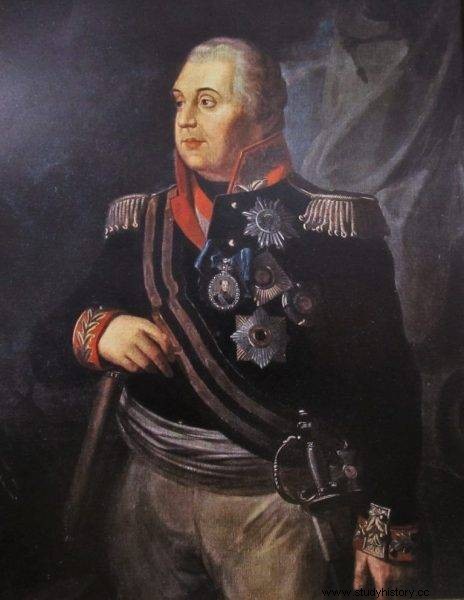
Commander-in-chief of the Russian troops, General Mikhail Kutuzov.
Suffice it to say that when the Grand Army reached Smolensk in mid-August, it had little to do with size. Its condition decreased more than twice and after the bloody conquest of Smolensk, "all the generals surrounding the emperor advised him to complete the campaign for this year and take positions along the Dnieper, which was a salutary advice" - recalled the then participant of the campaign, Lieutenant Henryk Dembiński. And inconsolably he continued:
But the emperor, believing that when he took over the capitals [Moscow - the ancient capital of the tsars], he would force Rossya to peace, he rejected all these advice and we moved on. You can see that did not have precise information about the country he was entering and thought he would feed the army with a brisk march using the resources that the residents will find. This thought is already difficult to implement in populous German countries, and completely unlike in the space we were about to pass.
Also terrified by the prospect of further march to Moscow, Fr. According to Krzysztof Jabłonka, Poniatowski was supposed to ask the emperor on his knees:“Sir, do not come to Moscow. We have already gone there twice ”(as the author of 100 Polish Battles ... writes it was probably about the expedition of Fr. Witold in 1408 and Hetman Żółkiewski from 1610).
Best position
Meanwhile, on the Russian side, the tsarist staff members were increasingly dissatisfied with de Tolly's tactic of constantly retreating from Napoleon. Even in the presence of the general's adjutants, the non-cotton Grand Duke Konstanty said: "You are a German, a traitor, a pest and you are betraying Russia" .
In this situation, not entirely convinced of his decision, Tsar Alexander entrusted the command to General Mikhail Kutuzov. Disliked by the ruler especially for his defeat at Austerlitz, a general who was approaching seventy, seemed to be the best candidate. And it was high time to change tactics, because the Grand Army set off from Smolensk on August 24.
The hopes placed on the new Russian commander were soon fulfilled. The tsarist soldiers finally stopped retreating and at the beginning of September fell in fortified positions about 130 km west of Moscow - near Borodino. In a letter to the Tsar, Kutuzov wrote: "The position near the village of Borodino, where I stayed [...] is one of the best that can be found in the area [Of Moscow] ". Yes, it was the last place to stop Little Corporal. Everyone waited for the final decision, but Kutuzov was probably waiting for something else.
Secret Weapon
The Russian commander must have looked to the sky hopefully, looking for a harbinger of future victory. However, it was not supposed to be an eagle or a lightning bolt, but the miraculous weapon promised by the tsar - a combat aerostat - a real god's finger on the enemy.
Around 1811, the German visionary mechanic Franz Leppich proposed Napoleon to equip his army with a hydrogen-filled steerable balloon. It was to be used not only to observe the battlefield, but also to effectively attack from the air. The whole thing was to be in the shape of an approx. 50-meter long oblong balloon (something like future airships) made of taffeta with a suspended gondola. It was to be powered by special paddles operated by several dozen gondola rowers. Leppich's project assumed that his aerostat would carry bombs and ... rocket launchers.
Leppich knew perfectly well that the emperor of the French at one time was an enthusiast of the military use of balloons, therefore he counted on the interest in his idea. What, then, must have been the amazement of the inventor when Napoleon firmly rejected his proposal. Moreover, the emperor forbade Leppich to experiment further.
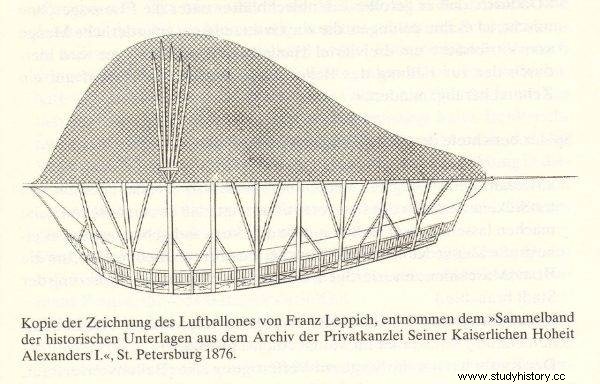
Sketch of an airship for Tsar Alexander I by Franz Leppich
This, however, did not intend to submit to the imperial dictate, but in the face of the threat of arrest, he fled to the court of the Württemberg king, Frederick I. The ruler, who remained under the French protectorate, but pursued a fairly independent policy, allowed Leppich to work, despite the fact that he was not at all interested in the achievements of the young engineer.
However, what Fryderyk did not care about, definitely liked the Russian ambassador, Countess who was present at the royal court. Alopeus. Through him, Alexander I. In a letter to Tsar Alopeus he described in detail a whale-shaped machine that could carry 40 people out of 12 thousand. explosives and able to cover the distance from royal Stuttgart to London in just 13 hours!
Tsar Alexander I's Wunderwaffe
The Tsar was immediately fond of such an idea. In the face of the upcoming confrontation with Napoleon, any way to gain an advantage over his opponent seemed to him good - even so unusual. So he offered Leppich, by a decree of April 1812, a lucrative job in Russia, where in Vorontsov near Moscow he was provided with the conditions and materials for the production of his "flying galley".
At the end of May, escaping under a changed name and with the help of secret tsarist couriers from the approaching Great Army, Leppich arrived at his also secret factory. The work has started.
Alexander Mikaberidze, a researcher of the invasion of Russia in 1812, writes that until July about 100 workers worked there in shifts of 17 hours each. At Leppich's request, skilled workers were even brought in from Austria and Germany, which could not be found in the Russian Empire. The inventor also assured the governor of Moscow Rostopchyn, supervising the work, that the money was well spent, and the first aerostat would be completed by August 15. And by the fall, whole squadrons will take to the skies over Moscow.
Unfortunately, time was running out, troubles and accidents at work multiplied (e.g. the steel structure was cracking, which required high-quality tool steel, which, in turn, was not produced in Russia and had to be imported from England), the costs grew at an alarming rate and the expected results were missing.
Aleksander, impatiently, paid an "unannounced" visit to Woroncow in July. He was then shown some elements of the machine. The tsar seemed so satisfied with the progress of the work that he informed Kutuzov about the construction of a miracle weapon . At the same time, he instructed him and Leppich to closely coordinate their actions during future raids on the Grand Army.
Broken promise
Meanwhile, August 15 has passed - the target date for putting the first balloon into service. Napoleon had already captured Smolensk and was approaching Moscow with great strides, and there was no trace of the announced prototype of the "flying galley". To make matters worse, the test flight that was finally carried out at the end of August was not very optimistic. The gondola, loaded with only two people, turned out to be too heavy for the gas-permeable shell, and the achieved meager height of only 12 meters made it impossible to test the effectiveness of the rowing propulsion and steering.
At the same time, ignorant of the problems with the implementation of the project, Kutuzov insisted on sending this miracle of technology. Almost on the eve of the battle of Borodino, he was to write to Rostopchin:“The emperor told me about the balloon being secretly prepared near Moscow. Can I use it, please tell me how to use it more conveniently? ”.
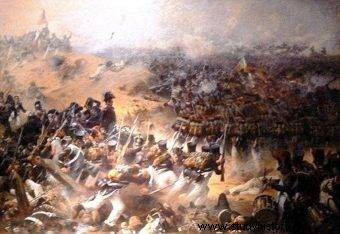
The attack of the French on the Great Redoubt in a painting by Julien Le Blant from 1831.
But he waited in vain for an answer. He also looked for in vain in the sky the foretold of victory. However, he could not give up Moscow "without fighting and losing honor, although that would be the wisest" - we read in 100 Polish battles ... So he had to descend to the ground and with his weary eyes embraced the Borodin fields, which in the coming days were to become a bloodbath , only overshadowed by the slaughter of World War I.
And Leppich benefited from tsarist favor and financial support for two more years. Eventually, however, even Alexander lost his patience. Not having a fully operational copy of the "flying galley" available, he finally cut Leppich from the funds, which forced him to leave Russia in February 1814. The inventor eventually settled in Bavaria, where he continued his work, which reportedly resulted in the creation of a machine for ... manicure.
